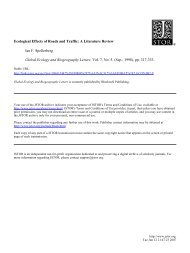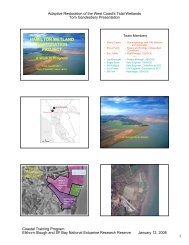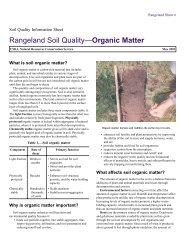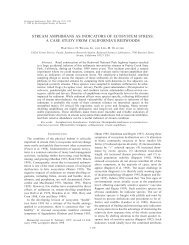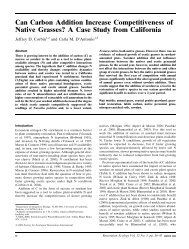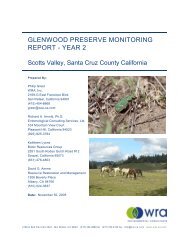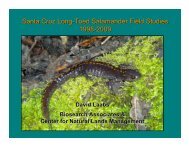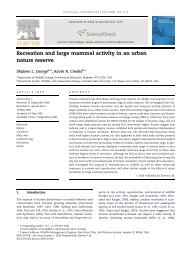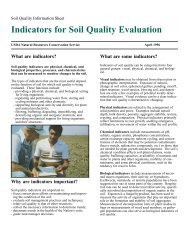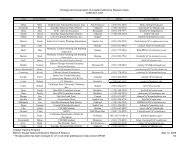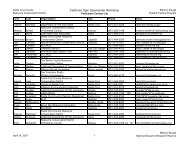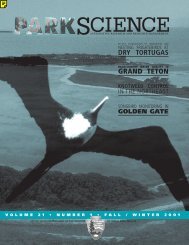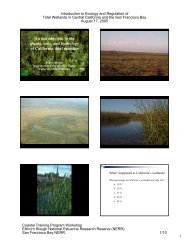BIRD POPULATIONS - Birdpop.org
BIRD POPULATIONS - Birdpop.org
BIRD POPULATIONS - Birdpop.org
- No tags were found...
Create successful ePaper yourself
Turn your PDF publications into a flip-book with our unique Google optimized e-Paper software.
FRANCIS GBOGBO AND DANIEL K. ATTUQUAYEFIOGhana by staff of the Ghana Game and WildlifeDepartment (aided by British ornithologists), inNovember 1985 and January 1986, indicated that13 of ~100 wetlands held ~80% of Ghana coastalterns, 85% of waders and 95% of herons(Ntiamoa-Baidu 1991). Eight of these 13wetlands, namely Keta Lagoon, Songor Lagooncomplex, Sakumo Lagoon, Densu Delta, MuniLagoon, Elmina Saltpans, Korle Lagoon andEsiama Beach, were considered to be of internationalimportance to waterbirds. On the meritof their importance as waterbird habitats, thefirst five were designated as Ramsar sites in 1992(Ntiamoa-Baidu and Herpburn 1988, Ntiamoa-Baidu 1991).Despite the extent of knowledge on birdmigration and wader populations worldwide,several gaps exist for West African areas,including lack of current data and therestriction of most studies to a few large sitessuch as Banc d’ Arguin in Mauritania and theKeta Lagoon in Ghana (Piersma et al. 1990,Piersma and Ntiamoa-Baidu 1995, Ntiamoa-Baidu et al 1998, Zwart and Piersma 1990).Previous reports, i.e. Ntiamoa-Baidu (1988,1991), Ntiamoa-Baidu and Herpburn (1988),and Ntiamoa-Baidu et al. (2000), are quicklybecoming irrelevant, needing desperately to beupdated with current data, particularly in thecontext of frequent reports of the loss ofwetlands and their qualities. According toAttuquayefio and Gbogbo (2001), most non-Ramsar sites in coastal Ghana are publiclyowned, unmanaged or unregulated resources.Gordon et al. (1998) reported a number of non-Ramsar wetlands such as Korle, Chemu, Teshieand Kpeshie, Fosu and Benya lagoons to bepolluted and no longer supporting bird life.Indiscriminate fishing, hunting of waterbirds,sewage disposal, cutting of mangroves andfarming have been identified as the majorhuman activities contributing to this alterationof these non-Ramsar sites (Attuquayefio andGbogbo 2001).In contrast, Ramsar sites on the coast receiveconservation attention including the implementationof civil works to minimise the impactof problems, the construction of trails and birdobservation points, the presence of wardens toensure general law enforcement and theprevention of bird hunting, restrictions on theuse of drag nets for fishing and the institution ofclosed fishing seasons. Nevertheless, discrepanciesalso exist in the nature and quality ofcoastal Ramsar sites. Available records indicatethat between 1992 and 2007, the total area ofDensu Delta, for instance, was reduced from58.9 km 2 to 46.2 km 2 by encroachment(Amankwah 1998, Wetland International 2007).The evidence that physical and chemicalproperties of wetlands on the coast of Ghanacontinue to change indicate that changes inwaterbird populations could occur and theseneed to be documented to enhance the managementof wetland and waterbirds. Comprehensivewaterbird studies in this area demandthe commitment of huge financial and humanresources that may not readily be available.Nevertheless, imprecise but useful populationtrends can be deduced if studies are carried outon a limited number of wetlands to be used asan index (Howe 1998). In that regard, thewaterbird numbers of four coastal wetlands arereported and discussed in this paper.METHODSSTUDY AREAThe study was carried out at four coastalwetlands in Ghana: Densu Delta and Sakumo,Mukwe and Laiwi lagoons. Densu Delta(5º31’N, 0º20’W), a Ramsar site, constitutes thelower reaches of Densu River’s water coursewhere it joins the Gulf of Guinea. It provides asignificant sanctuary for resident and migratorywaterbirds, having an estimated 57 species and35,000 individual waterbirds (Grimble et al.1998). The vegetation is dominated by Avicenniaafricana, Sesuvium portulacastrum, Paspalumvaginatum, Sporobolus virginicus, Cyperusarticulatus and Imperata cylindrica (Oteng-Yeboah1999). Sakumo Lagoon (5º37’N, 0º02’W), also aRamsar site, had a cover of 13.6 km 2 in 1992 butwhich was reduced to 13.4 km 2 by 2007(Amankwah 1998, Wetland International 2007).It is the third most important site for shorebirdsalong the coast of Ghana (Anku 2006). Its vegetationconsists mainly of Paspalum vaginatum,Sesuvium portulacastrum, Philoxerus vermicularis,and Typha australis with scanty remains ofAvicennia africana (Oteng-Yeboah 1999).Mukwe Lagoon (5º36’N, 0º03W) has a totalland area of 2.6 km 2 . Its vegetation consists of[57]



